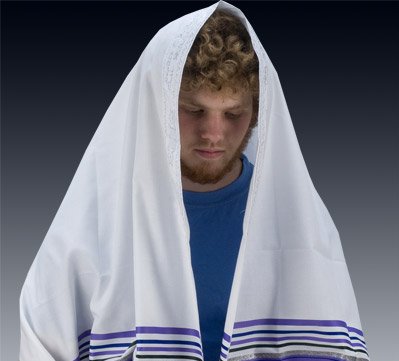31 August 2010 (Shleshi/Bikkurim)
Day #169, 5934 AM
Teshuvah #23 Tallit
Repenting of Male Head Coverings

Continued from Part 1
Throughout Judaism and the Messianic Movement the widespread practice of men covering their heads with tallit or prayer shawl while praying and worshipping is in direct violation of Scripture, sacred tavnith or pattern, and the historical witness. The apostle Paul declared emphatically:
"Every man praying or prophesying, having his head covered, dishonours his head (Yah'shua). But every woman who prays or prophesies with her head uncovered dishonours her head (her husband), for that is one and the same as if her head were shaved. For if a woman is not covered, let her also be shorn. But if it is shameful for a woman to be shorn or shaved, let her be covered. For a man indeed ought not to cover his head, since he is the image and glory of Elohim (God); but woman is the glory of man" (1 Cor.11:4-8, NKJV).
This apostolic injunction has sadly led many Messianic Jewish and Israelite men to reject the New Testament writings of Paul (Sha'ul) because they are of the mistaken belief that since Talmudic Jews wear headshawls (tallit) and skullcaps (kippa or yarmulke) that Paul must be wrong and the Jewish traditions right. However, as scholar Michael Marlowe states:
"Among Jews the custom of covering the head for prayer did not arise till the third or fourth century of the Christian era. Some theorize that Jews adopted the yarmulke in a reaction against Christian customs. For example, the Jewish scholar Abraham Millgram, in his book Jewish Worship (Jewish Publication Society, 1971), writes:
'As the persecutions of the Church increased, the Jewish aversion to everything Christian deepened. The uncovering of the head became associated with Church etiquette and therefore became repugnant. To worship or even to go about with an uncovered head was regarded as imitation of the Christians and an act of irreverence' (p. 351).
"See also the article Head, Covering of, in the Encyclopedia Judaica, Vol. 8 (Jerusalem: Keter Publishing House, 1971), in which it is said that one Jewish sage declared that "since Christians generally pray bareheaded, the Jewish prohibition to do so was based on the biblical injunction not to imitate the heathen custom." (p. 5.) The assertion that the men covered their heads for prayer in New Testament times, often found in the older commentaries (such as John Lightfoot's Horæ Hebraicæ et Talmudicæ) was based entirely upon statements about headcoverings in the Talmudic tractates of late antiquity. But in the past hundred years scholars have become much more cautious about the use of rabbinic literature dating from the fourth century as a source of evidence for first-century practices" (Michael Marlowe, Headcovering Customs of the Ancient World).
There is no evidence in the Torah, in the Bible as a whole, or from the history of the period, that men ever wore headcoverings for spiritual or religious reasons as was always required of women - rather, men were commanded to wear tzitzit or tassels to demonstrate their obedience and submission to Yahweh. Indeed, the New Testament positively asserts that they should not (see 1 Corinthians 2:11-16) because Yah'shua is their covering and He, who is their Head, being in Heaven, is invisible. In the same way that Yahweh hangs the earth upon nothing [visible], so the authority of Elohim over men is likewise invisible (Job 26:7).
Many messiancs often object by pointing out that tha Aaronic Priesthood, along with the Cohen Gadol or High Priest, were required to wear turbans. Since they were engaged in temple worship, this proves, they claim, that men had their heads covered. This is not, however, correct. The turban that Aaronic priests wore had a hole in the top. It was like a headband. It was made of a piece of linen wrapped around the head in a circular fashion. It did not cover the top of the head. It was hollow and shaped like a ring or doughnut. It allowed the top of the head to show, just like a king’s crown, a Greco-Roman wreath or headband, a monk’s hairstyle, a Christian halo, some Catholic mitres, some Muslim turbans and a Muslim headband. It was mainly for the protection of the golden engraved plate or insignia on which was written, "Set-Apart to YHWH" (Ex.28:36; 39:30; also see Zech.14:20-21), and helped beautifully display the jurisdiction and rôle of the priest. Authoritative men in ancient Israel did not
cover the top part of their heads to exercise their power. The top of a man’s head is the highest part of a man and it denotes his glory. It is the scepter for his power, and the throne (office) for his final authority. It should thus be left uncovered when a man is exerting authority, especially in prayer and when prophesying.

The use of a tallit, yarmulke or headcovering by men in worship and prayer is a man-made tradition, contrary to scripture and a denial of the headship of Yah'shua over men. It is as rebellious for men to wear tallit as it is rebellious for women not to cover their heads during prayer and worship. The wearing of a tallit is therefore anti-messianic and blasphemous. We urge all men everywhere who wear tallit (prayer shawls or yarmulke) during prayer or worship to make teshuvah, to stop dressing like women, abandon Talmudic anti-messianic Jewish traditions, and let Yah'shua (Jesus) be their head both literally and symbolically.
Finally, women should not wear tallit either for several reasons:
- 1. Women are not supposed to wear tzitzit, and tzitzit are worn on the corners of tallit;
- 2. The tallit was invented by Talmudic Jews to anathametise the Messianic/Christian faith; and
- 3. A woman's headcovering should not resemble anything worn by men (and vice versa), even if the men wear items of clothing in violation of Torah
If this has provoked any anger or rage in men who wear tallit hearing this message then I have to ask you to soberly consider the source of that rage, because all anti-messianic traditions have a murderous spirit behind them. Tallit is not in Torah but an anti-Yah'shua statement by men that they will not follow the Messiah, and of the same spirit as those men who originally murdered Him. So what has godliness to do with ungoldiness, or the spirit of shalom (peace) with the spirit of murder?
I realise this may hurt some of you men but the truth is the truth and we must honestly deal with it. "Indeed, let Elohim (God) be true but every man a liar" (Rom.3:4, NKJV). Yah'shua is a lot better than a piece of offensive cloth which robs a man of his authority and blasphemes the Most High. If you are a tallit-wearer, then I urge you to make teshuvah and follow scriptural tavnith. Shalom!
Continued in Jewish Traditions Part 3
Continued in Tallit Part 2
Comments from Readers
[1] "The reason why Jewish men pray with head covered is simple and Biblical. They are lamenting the destruction of the temple. Covering the head is the Biblical way for a man to show shame, repentance and sorrow. See 2 Samuel 15:30, Esther 6:12, Jeremiah 14:3-4. Now where it gets interesting is that Jesus decreed the destruction of the Temple (Matthew 24:2, Mark 13:2, Luke 19:44, Luke 21:6). So Messianic Jews who follow Christ should not be lamenting the destruction of the temple. Jews who reject Meshiach lament the loss of the Temple, and I would argue that the tradition of Jewish head shawls is a lament for the Temple. But that comes back to the point in your article, the head shawl is anti-messiah since it is a rejection of the Messiah's judgment which he pronounced upon the hard-hearted" (KG, Kenya, 15 May 2013)
Questions from Readers
[1] Q. "What do you say to those who use 2 Samuel 15:30 as justification for wearing a kippa?" (SW, Germany, 8 March 2022)
A. Then why don't you go barefoot too as David and his entourage did as they climbed Mount Moriah? Because headcovering (not a little beanie) + going barefoot = sign of mourning. This has nothing to do with walking on holy ground.
 Share
Share
|


